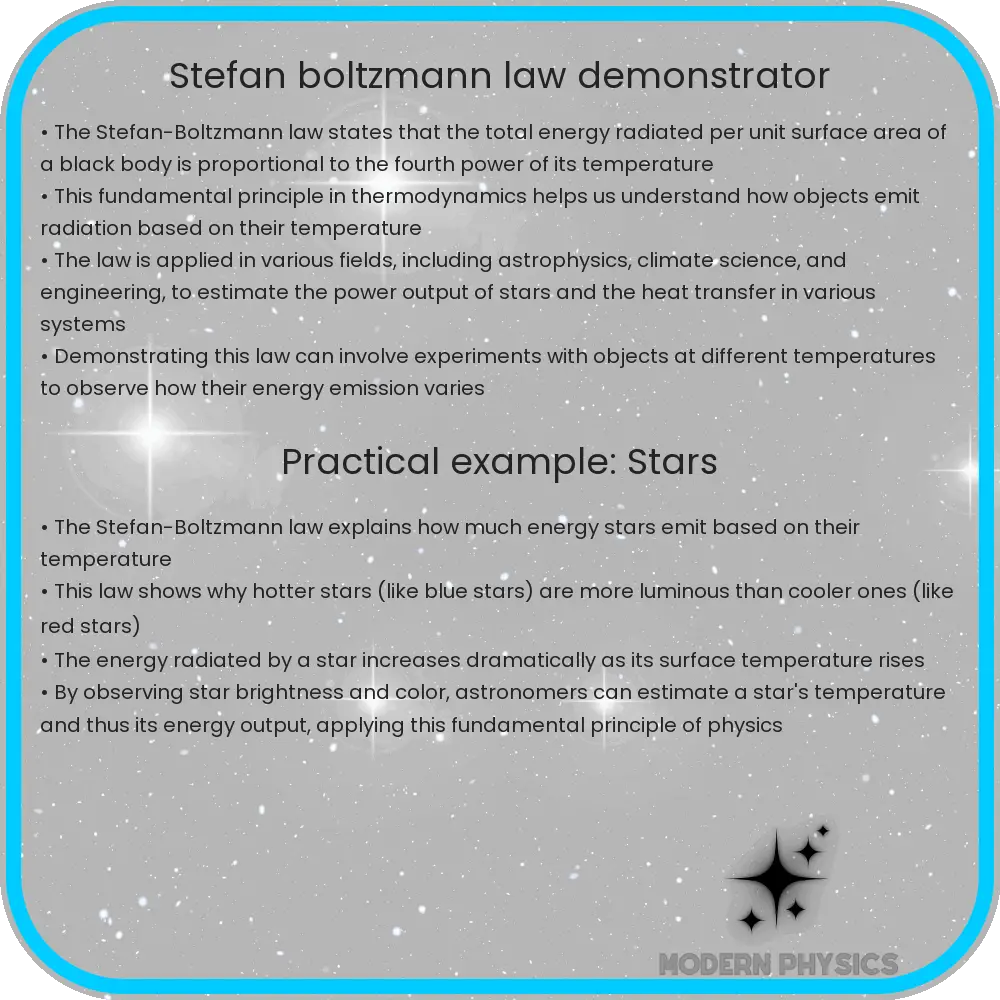Explore the Stefan-Boltzmann Law with an interactive demonstrator. Understand its applications in science and engineering for practical learning.

Understanding the Stefan-Boltzmann Law through a Demonstrator
The Stefan-Boltzmann Law is a fundamental principle in the field of thermodynamics, playing a crucial role in understanding thermal radiation. The law, named after Josef Stefan and Ludwig Boltzmann, states that the total energy radiated per unit surface area of a black body is directly proportional to the fourth power of the black body’s temperature. This concept is mathematically expressed as \( E = \sigma T^{4} \), where \( E \) is the energy radiated per unit area, \( T \) is the absolute temperature in Kelvin, and \( \sigma \) is the Stefan-Boltzmann constant, approximately equal to \( 5.67 \times 10^{-8} \) W/m2K4.
An efficient, accurate, and educational Stefan-Boltzmann Law Demonstrator can provide a hands-on experience for students and enthusiasts, making the abstract concept tangible and easier to comprehend. Such a demonstrator typically includes components that allow users to vary parameters like temperature and surface area, and then observe the resulting changes in radiation.
Key Features of a Stefan-Boltzmann Law Demonstrator
- Interactivity: A key feature of an effective demonstrator is its interactivity. Users should be able to adjust variables like temperature and observe the corresponding changes in radiation, allowing for a practical understanding of the law.
- Accuracy: The demonstrator must provide accurate measurements of temperature and radiation. This accuracy is crucial for validating the Stefan-Boltzmann Law and for educational purposes.
- Educational Value: It should include educational resources, such as guides or digital interfaces, explaining the theory behind the law and how to interpret the data from the demonstrator.
Integrating such a demonstrator into educational curriculums or research facilities can significantly enhance the understanding of thermal radiation and its practical applications. For example, in the field of astronomy, the Stefan-Boltzmann Law is used to estimate the temperature of stars based on their luminosity. In engineering, it helps in the design of radiative heat transfer systems.
By combining theoretical knowledge with practical experiments, the Stefan-Boltzmann Law Demonstrator not only aids in comprehending a critical physical law but also ignites interest and curiosity in the field of thermodynamics.
Practical Applications and Conclusion
The practical applications of the Stefan-Boltzmann Law are diverse and impact several scientific and engineering disciplines. In the field of climate science, the law is essential for understanding the Earth’s energy balance and the effects of greenhouse gases. Engineers use this law to design more efficient thermal insulators and radiators, crucial for building and vehicle design. Furthermore, in the realm of materials science, the Stefan-Boltzmann Law assists in studying the thermal properties of various materials, enhancing their applications in different temperature environments.
For educators and students, the Stefan-Boltzmann Law Demonstrator serves as an invaluable educational tool. It bridges the gap between theoretical physics and real-world phenomena, making complex concepts more accessible and engaging. By observing the effects of changing temperature on radiation firsthand, students gain a deeper understanding of the law and its implications in various scientific fields.
Conclusion
In conclusion, the Stefan-Boltzmann Law Demonstrator is not just a tool for understanding a fundamental law of physics but also a gateway to exploring a wide range of applications in science and engineering. Its interactivity and accuracy provide a unique learning experience, transforming abstract concepts into tangible experiments. This demonstrator proves invaluable in educational settings, fostering a deeper appreciation and understanding of thermodynamics and its role in our daily lives and the universe at large. The integration of such demonstrators in educational curricula can significantly enhance the learning experience, sparking curiosity and promoting a hands-on approach to science education. The Stefan-Boltzmann Law, with its broad applications and fundamental importance, continues to be a pivotal area of study, and tools like the demonstrator play a crucial role in its exploration and comprehension.
